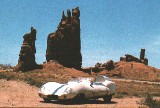
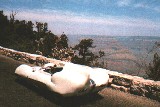
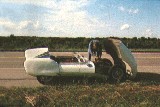
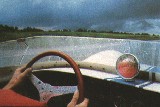
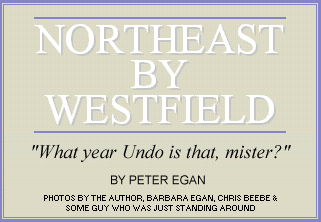
SOUTH OF AMBOY, California, the Mojave Desert is not really sports
car country. It looks like a good place for an A-bomb test or
a Sabre-Jet attack on a giant mutant spider. It is mirage country,
where everything shimmers in the distance, and you cross the white
and dazzling salt flats of Bristol Dry Lake half expecting T.E.
Lawrence to come riding out of the heat waves. The roads through
this territory run straight as the crow flies, only it's too hot
for crows and there's nothing for them to drink so there aren't
any.
There aren't many open British sports cars, either. In fact we
were nearly alone on the highway, which on an afternoon in early
June was positively humming with heat. My wife Barbara and I were
on our way to Elkhart Lake, Wisconsin. We were cruising across
the Great American Desert in a small English car, designed a quarter
of a century ago to run on narrow green lanes and mist shrouded
race tracks in a country where sunlight is about as common as
a lunar eclipse. I was behind the wheel, watching the water temperature
gauge with one eye and trying to remember if there was any place
in England where you could drive upgrade all day in 110-degree
weather. I didn't think there was.
This particular English sports car was a Westfield. The Westfield
is a replica of a Lotus Eleven, a very successful sports racing
car from the late Fifties and one of the cars that made Colin
Chapman a household name in households that love fast, agile,
nice-looking cars. Just three weeks prior to our trip, the Westfield
had arrived on Road & Track's doorstep as a disassembled,
unpainted kit. Driven by some kind of tangential homing instinct,
I'd spent all of my nights and weekends virtually living in the
R&T garage, subsisting on a health fad diet of Coke and cigarettes,
trying to assemble the car in time to make the June Sprints.
No Midwesterner, fallen-away or otherwise, likes to miss the Sprints,
which is an annual rites of spring tradition held at what may
be the most beautiful sports car track in the country. The event
is half SCCA National and half medieval festival, drawing a huge
number of entrants from all over the country. An added incentive,
if we needed any, was that our friends Chris Beebe and crew would
be racing his D-Production Lotus Super Seven.
The night before we left on this grand trip I was still working
on the car (proof that work expands to fill the time allotted)
when our Editor Emeritus, Tony Hogg, stepped into the lighted
chaos of the R&T garage. Tony was especially interested in
the project because he had owned and raced an Eleven in England
and Europe during the late Fifties. Tony lit a cigarette and asked
how things were going. Pieces of the car were still scattered
all over the floor.
"Almost finished," I said. "The car has to be ready
to go tonight because Barb and I are leaving for Elkhart in the
morning."
Tony raised one incredulous eyebrow. "You're driving that
bloody thing all the way to Elkhart Lake?"
"Yes," I said. "It's going to be sort of a motorcycle
trip on four wheels. The Westfield doesn't have a full windscreen
and the convertible top isn't in production yet, so we're taking
rainsuits and helmets. It'll be interesting," I added, "to
see how an open sports racer works as a cross-country touring
car."
Tony gazed at the Westfield for a few moments and took a thoughtful
drag on his cigarette. "I should think," he said in
his best detached British way, "that it'll be just bloody
awful."
Awful, of course, was a matter of perspective. Barb and I had
crossed the country a half-dozen times on various motorcycles,
so the prospect of leaning back in a comfortable seat, largely
protected from the wind, seemed relatively luxurious. The Westfield
also had more luggage space than most motorcycles. There was storage
space on the wide armrest panels inside the doors and on the floor
beneath the arched knees of driver and passenger. The rear body
section swung upward, revealing a flat tray that was part of the
floor pan. This area was subject to dust and water spray from
the rear tires, but luggage could safely be wrapped in plastic
garbage bags and lashed to the frame and spare tire. The Westfield
was not the Globemaster of cars, but we wouldn't have to leave
our toothbrushes behind.
The only slightly awful part was taking off on a 5000-mile journey
with an untested car, with virtually no time to run the engine
in. Adjustments would be made on the road. I packed enough tools
to field-strip the car if necessary and repair nearly anything
en route. Fortunately the Westfield is a very simple car held
together with only a few conventional sizes of nuts, bolts and
other fasteners, so the toolbox was small.
I finished the car at midnight, drove it back to our house and
packed what few clothes I needed. I told Barb we should get up
at 4:00 a.m. and leave in the early morning darkness to avoid
crossing the Mojave in the afternoon heat, so we set our alarm
and went to bed.
Getting up at 4:00 a.m. sounded like a much better idea at midnight
than it did when the alarm went off at 4:00 a.m. We went back
to sleep and eventually got up at 9:00 a.m. By 10:30 the car was
packed and we pulled out of the driveway into a clear, hot summer
morning; mad dogs and English car, off toward the noonday sun.
Part of the plan on this trip was to avoid Interstates at all
cost, so we crossed the California desert part way on Highway
62 and then turned north toward Amboy. This is all 2-lane blacktop
that runs through such oases as Yucca Valley, Twentynine Palms
and Essex, with miles of cactus, Joshua trees and empty desert
between.
By the time the freeways of greater and lesser L.A. had spilled
us onto these emptier roads, it occurred to me the Westfield had
a remarkably good highway ride for a taut, light sports car. Not
nearly as jittery as might be expected.
The added weight of our luggage no doubt helped, and the car cruised
serenely at 60 to 70 mph with a sort of hunkered-down bantamweight
Cadillac feel. A bit too hunkered down at times. Even with the
front springs jacked up all the way on their platforms, the lowslung
oil pan occasionally scuffed the pavement and random dead things.
Otherwise, the Westfield made a fine highway car. The side-mounted
BSA muffler gave out a lovely, throaty purr. Even at 75 mph the
cockpit was relatively tranquil. (Don't ask relative to what.
An N2S Stearman, maybe.) There was some backdraft on the passenger's
neck, but the headrest/fin did a remarkable job on calming the
air around the driver's head. In normal driving position you looked
over the windscreen rather than through it, but the plexiglass
deflected nearly all of the wind over your head. Stones and insects,
however, refused to follow the wind flow, so goggles or a helmet
with a face shield was nice, especially around gravel trucks.
Until about one o'clock in the afternoon the car ran perfectly,
with the water temperature needle centered on Normal. After that
the desert temperature climbed to just over 100 degrees and the
needle moved halfway to Hot. When we started a long upgrade climb
near Yucca Valley the needle pegged itself solidly on Hot. The
intense engine heat, aided by an exhaust header that wraps around
the front of the left footwell, also began to warm up the driver's
compartment. The pedals got hot and the handbrake lever began
to burn my leg, so I wrapped a sweatshirt around the handle. We
stopped at a country store, parked under a tree and got out to
cool down for a while.
I poured down a quart of Gatorade and raised the Westfield's hood
to look things over. I smelled gasoline and discovered that the
exhaust header heat was boiling fuel out of the float bowl on
the rear SU carb. Willard Howe, the U.S. Westfield importer, had
warned me this could happen on blistering hot days, so I had cut
a vent in the aluminum bodywork behind the carb to let the hot
air out. This, obviously, was still not enough. The Westfield
was a brand-new car, untested in this climate and being driven
on a true shakedown run, so I began a list of small improvements
and modifications to be made when we got to Chris Beebe's shop
in Wisconsin. I got out a notebook and wrote: " 1. Asbestos
heat shield for driver's footwell. 2. Improve heat shield between
carbs and header. 3. Make cold air duct for carbs. 4. Move radiator
into nose with full shrouding and fit electric fan."
I poured some cool water on the carbs and we took off: climbing
and warming our way over the Bullion Mountains and down onto the
flats of Bristol Dry Lake.
"What are you spraying for?"
"Roaches."
"Talk about service," I said when the man was gone.
"You won't find roach spray much fresher than that."
We filled our almost-empty fuel tank and calculated our mileage
at 44 mpg. Not bad for a fast car with a new engine. The tank
held only 5 gal., but with that mileage we didn't have to start
looking for gas stations much before 160 miles. The Westfield's
small frontal area and aerodynamic shape certainly didn't hurt
its fuel economy: at highway speeds the car felt almost as if
it were traveling through a vacuum, and its ease of acceleration
at passing speed added to the sensation. With the big MGB wire
wheels and the standard 4.20:1 Sprite rear end, the engine was
turning a fairly relaxed 3700 rpm at 60 mph.
We passed through Essex, California (pop. 150); one of those places
that makes Paris look like a huge glamorous city near a nice cool
river. A sign on a building said, "Thanks to Johnny Carson,
Essex has TV!" I figured there was a story there somewhere,
but it was too hot to stop and ask.
Turning onto the inevitable Interstate long enough to get ourselves
out of California, we headed down I-40 toward the green banks
of the Colorado River, past the rock spires of Needles.
On the Interstate the Westfield attracted an incredible amount
of attention. People rolled down their windows to ask what it
was, elderly couples smiled and waved and a Bible school bus listed
to one side as all the children ran to the windows. Cars followed,
passed, dropped back and followed again to get a better look,
and people going the other way on the Interstate actually honked
and waved from across the median. Wherever we stopped, the Westfield
created a minor interrogatory riot.
Nearly everyone asked (1) what kind of car it was, (2) what kind
of engine was in there, (3) was the engine in the front or the
back, (4) how much did it cost, (5) what kind of mileage did we
get, (6) where were we going to and coming from. and (7) what
were we going to do when (not if) it rained. A few fully grown
people asked if they could just please sit in it for a minute.
At a gas station I helped a husky, sunburned 50-year-old farmer
in overalls slide down into the passenger seat. He looked around
himself and said to his wife, "Now this is all right."
I felt as though we were barnstorming the first airplane across
the country. I think we could have charged money for rides. The
car had some elusive magic of shape and scale that stirred the
imagination.
We passed through Kingman and late in the afternoon began climbing
into the cool green Arizona mountains. After a day in the desert
the pine country of the Prescott National Forest was like an-other
planet. Just after sundown we swerved to avoid three deer crossing
the highway and decided the nearby town of Williams would be a
good place to stop for the night. We checked into a motel, covered
the car and walked off in search of a stiff drink.
In the morning I got up early to retorque the cylinder head and
adjust the valves on our green engine. An Australian gentleman
walked out of his motel room and said, "Ha! A Lotus Eleven!
With the car cover on in the dark last night I told my wife it
was a D-Type Jaguar. Nice car, either way."
We stopped for fuel and the kid at the gas station walked around
the car, obviously looking for an emblem or some sort of make
identification. He finally got down and read the word engraved
in the knock-off hubs, and I saw him mouth the word, "UNDO."
I thought for a moment he was going to ask the classic question,
"What year Undo is that, mister?" Alas, people are more
sophisticated these days, and in the end he asked, in his best
Steve Martin imitation, "Now what kind of a dang deal is
that?"
Barb took the first stint at the wheel and we headed up to the
Grand Canyon in clear, cool morning weather. The car was running
beautifully. When we entered the National Park. people seemed
to be leaving in droves, but we were almost alone going in. I
hypothesized that Editor John Dinkel was holding court at the
Main Lodge, telling his favorite puns. We drove to the rim of
the Grand Canyon and I tried to stifle my usual pathetic reaction
to the wonders of nature, in which I lament at having the wrong
camera lens. Barb said, "I wonder what the Indians thought
when they first of t walked up to the edge of this canyon."
'Probably, `Wait'll the white man sees this. The eviction notice
is practically in the mail.' "
On the winding road out of the park we came up behind our nemesis,
a parade of big dumb lumbering motorhomes. I noted with interest
that these things all have names to suggest speed and grace, like
Flying Arrow, Golden Eagle and Apache Brave.
We passed through the Hopi Indian Reservation and the beautiful
red pastel rock formations of the Painted Desert, which was almost
as hot as the Mojave Desert but slightly dustier. The heat in
the Westfield's footwell at noon was astounding. I considered
stopping at a supermarket and propping a frozen turkey against
the gas pedal. That way my feet would stay cool and dinner would
be ready by the time we got to Durango.
Just across the Colorado border we pulled into the town of Cortez
right on the tail of a huge parade passing down Main Street. It
was Frontier Days or Yahoo Centennial Days or something. We passed
through just after the parade, and the street was still lined
with people, several of whom were sober. We drove down a 3-mile
gauntlet of whistling and shouting citizens. Most, I'm sure, thought
we were part of the parade, a late entry. We smiled and waved
at everyone, and Barb said, "I wonder if I should sit on
the back deck of the car and blow kisses."
I looked at some cowboys who had just staggered out of a bar and
said, "Better you than me." We crawled through town
and emerged on the other end with the temperature gauge pegged,
inhaling vapors of hot horse apples sizzling on an overheated
Austin sump.
Climbing back into the Colorado Rockies, we made it to the old
mining town of Durango by sunset and checked into the beautifully
restored old Strater Hotel. We put our luggage in the room, which
was done up in grand 19th Century style-hardwood wainscoting,
brass bed, stone pitcher and bowl, etc. - and went out for a Mexican
dinner. We came back later and watched The Thing on our 19th Century
color TV
After an early Sunday morning start into a cool, slightly misty
day we stopped in Pagosa Springs for breakfast at a Main Street
cafe. As we sat drinking coffee, the cafe's clientele defected
en masse to the sidewalk for a look at the Westfield. The lady
at the cash register said, "I hope you folks aren't too hungry
for your bacon and eggs. That's the cook out front lookin' at
your car."
People driving home from church were double-parking their cars
and pickups, jumping out in their Sunday best suits and cowboy
boots to look at the car. We went out and joined the throng.
It was hard to know what to call the car when people asked. Westfield/Lotus
Eleven was a little unwieldy, so we usually picked one or the
other and said it was made in England. The engine was another
problem. If you told people it had an MG engine, they'd whistle
and say, "Whoo-eee! I bet that thing really flies!"
If you admitted it was an MG Midget engine, they'd say things
like, "Ha! Probably smaller than my kid's Suzuki dirt bike
engine. Bet she gets good mileage, though." Caught off guard,
we found ourselves describing it, variously, as an MG, MG Midget,
1275 MG Midget, Austin, Austin A-series 1275, Austin-Healey, Sprite
or BMC engine. For the sake of consistency, Barb and I collaborated
halfway through the trip and agreed to call it an Austin Healey
engine, as that seemed to provoke the loudest murmurs of approval.
East of Del Norte we cruised steadily downhill through an ever-widening
valley and I had the feeling we were about to be spit out of the
mountains of the gold- and silver-mining West onto the prairie
and cattle ranch West. The car was humming along perfectly and
it was still spring in the mountains. The cottonwoods and aspens
had that lacy green look and the meadows were in bloom. It was
odd, here and there, to see rustic old ranch houses with gigantic
parabolic TV receivers in their front yards, like an Eighties
update of Gene Autry and the Radio Ranch. It looked all wrong.
Near Monte Vista we hit a dust storm that looked from a distance
like a moving river of fog about 600 ft high. We drove into it
to find big pieces of thing blowing across the road, mingled in
with the stinging sand. Tumbleweeds went by so fast they weren't
even tumbling. We passed an outdoor movie theater and 1 explained
to Barb that in order to hit the screen the projectionist would
have to aim 20 ft to the left to correct for wind. "And on
a bad night," I added. "the movie ends up in Kansas."
The river of sand died away so we took our helmets off and put
our caps and sunglasses back on. It was more pleasant to drive without helmets, so we reserved these for rain and gravel storms.
Highway 50 took us into Kansas, following the green willows and
pretty towns along the Arkansas River. I'd been through only the
corners of Kansas before, so most of my preconceived notions of
the state were based on the opening moments of The Wizard of Oz,
with its flat, sepia-toned landscape and evil tornadoes. In the
early summer, at least, the Kansas we saw was a farmland of rolling
green contours interspersed with small towns that radiate a wonderful
quality of permanence and dignity. Our route across Kansas was
one of the most beautiful parts of the trip.
The presence of evil tornadoes, however, is no myth. We stopped
for lunch in Jetmore, Kansas and noticed some very dark thunderheads
building up in the northwest. I asked a farmer at the cafe if
tornado season was over and he said, "hope. Just getting
into full swing." As we left town a yellow biplane crop-duster
swept across the highway in front of us, flying against a backdrop
of dark clouds and distant pitchfork lightning. Hitchcock would
have loved it.
I looked around at the sky and thought, this, by God, is real
weather. Not like in California where it just kind of creeps in
and sits on you. In Kansas you watch the weather at work around
you like some kind of big unpredictable machine where thunderheads
and shifting winds are the moving parts. Advancing clouds have
a relentless quality; you can look around the broad horizon and
see several storms developing at once.
Unlike the mountains. where you are often locked into a single
route of travel, the plains are mapped out in a great grid of
highways, so by zigzagging across the state you can play checkers
with the weather and miss the worst storms. As in checkers, of
course, sometimes the weather jumps you and wins. And in Kansas,
sometimes the weather comes along and blows all the checkers right
off the table.
At five o'clock in the afternoon we ran out of zigzag options
and found our-selves in the middle of a blinding thunderstorm
illuminated by tree-ripping lightning bolts. It hit us so hard
and doused us so completely we didn't bother to get out any rain
gear. I just put my foot in it and headed to the closest motel
in Junction City. There we turned our room into a vast drying
rack for clothes, sleeping bags and tools from my water-filled
toolbox. In heavy rain, it turned out, the rear tires churned
great quantities of rainwater up into the rear bodyshell. so that
it ran down our seatbacks like a waterfall and filled the car.
I added, "5. Needs inner fender wells" to my improvement
list.
The morning after the storm was cool and clean with a sky the
color of morning glories. Willard Scott, on our motel TV, said
there'd been 25 tornadoes in the plains states the previous day,
with more on the way. As we headed across the Missouri River,
however, there wasn't a cloud in the sky.
Northern Missouri was our first exposure on the trip to real sports
car country. Narrow winding roads, hills and steep valleys, 1-lane
bridges and trees forming a tunnel of shade over the road.
It was also the most dangerous section, because farmers with tractors
and manure spreaders were not ready for us. Nothing in their lives
had prepared them for the specter of a small white bomb of a car
with blue racing stripes to come drifting around a blind corner
or bearing down at high closing speeds. We weren't driving too
fast for the Westfield; just too fast for pickup trucks and hay
wagons with a relaxed indifference to the centerline. After a
few close calls we decided to slow down and live to enjoy the
scenery. The Westfield was in its element, running cool and handling
the road flat and quick as a go kart.
On Highway 6 1 saw a sign for a place called Novinger and turned
off the road, down the town's main street. My parents had lived
in Novinger for a couple of years before I was born. My dad had
bought a small weekly paper there with his Navy savings at the
end of World War 11. 1'd heard so many stories of this little
coal mining town that it existed larger in my imagination than
the places I'd seen myself.
It turned out the coal mines are closed now and the only people
living in town are those who work elsewhere. We drove down a ghost
town main street of dusty, boarded-up storefronts, peeling paint
and faded signs. It looked like the town where Bonnie and Clyde
tried to rob the bank and found it closed. A heavy-set young man
with, believe it or not, a Mohawk under his seed cap and a T-shirt
listing Ten Excuses for Not Having Sex gave us a tour of Main
Street and pointed out where all the stores had been. He couldn't
remember a newspaper office ever having been in the town. We stopped
for a drink in the one open bar, and no one in there remembered
either. Novinger was like a lot of country towns we passed through.
It was a little too small to support commerce, so people just
gave up on the idea of having a town and quietly moved away. What
remained was a house collection, with bar.
Driving into southern Iowa at sunset; we passed a slow semi on
a long hill. I casually looked up at the driver as we passed and
was greeted with a blinding flash of light. As my vision recovered
I realized the driver was grinning and waving a small Instamatic
flash camera at us. He gave us the thumbs up sign and backed off
so we could pass. As we pulled ahead another flash was fired at
our backs. We drove into Ottumwa and found a motel with blue dots
all over it.
In the morning I checked the oil. It was down a half-quart, after
2000 miles of driving in hot weather. Our best mileage up to that
point had been 52 mpg (Kansas tailwind) and our worst had been
43 mpg (Colorado mountain headwind). None of the nuts and bolts
I checked had loosened up, and after five days the car was running
cool and strong. Valve clearances hadn't changed since Williams,
Arizona, and the plugs were a nice tan color. The points looked
good, timing was spot-on and the oil pressure was still at 55
psi hot. I'd left California fearing the Westfield night be a
slightly fragile, fussy sort of car on a long trip. Now, a few
hours from the Wisconsin border, I'd begun to think of it as a
remarkably tough, durable machine. Most of my constant listening,
checking and adjusting had been wasted effort. As we slid into
the car on the sixth and last day, it was like putting on a comfortable
pair of shoes. The sound of the engine starting on that clear
summer morning was pure music.
We crossed the Mississippi near Dubuque at mid-morning and headed
into the green Ozark-like hill country that is southwestern Wisconsin.
My growing up in that area has nothing to do with a personal opinion
that this is some of the most beautiful country on earth. It was
shaded valleys, rivers, red barns and villages all the way into
Madison. From there we drove the back roads to Elkhart Lake, passing
through pretty towns like Greenbush and Glenbuelah, and all of
a sudden we found ourselves braking and downshifting into the
city limits of Elkhart Lake, something I'd first done 18 years
ago in my green TR-3. We motored down the shaded village streets,
past the lawns and white porches of Siebkin's hotel and headed
south toward the gates of Road America.
On the seventh day the Westfield rested beside the track. Chris
Beebe and his Lotus Super Seven did all the work, winning the
D-production race in a hard-fought battle. About 30 of us who
like to celebrate such things retired to our traditional campground
on the shores of Lake Michigan, pitched tents. ate grilled bratwurst
and drank Bohemian Club, the official beer of southwestern Wisconsin
Lotus Seven owners and their ilk. In the morning all evidence
suggested we'd had a good time.
When the race weekend was over, Barb had to fly back to California
and her job, so Chris Beebe agreed to drive the Westfield back
across the country with me. Before leaving, we worked on the car
for three days at Chris's shop in Madison. We made a new heat
shield for the carbs, ducted air to them, moved the radiator forward
in the nose and added shrouding, bolted a piece of asbestos to
the driver's footwell, installed some inner fenders over the rear
wheels and jacked the front ride height up with taller springs.
(Several of these improvements have now been made by the Westfield
people.)
The return trip was pleasurable and uneventful, and we made the
2200 miles without having to lay a hand or wrench on the car.
Our small mechanical improvements worked wonders, eliminating
the Westfield's few irritants. The engine ran cool, the rear SU
no longer overheated, the footwell was incapable of roasting a
turkey and the oil pan didn't bottom on gum wrappers and lost
coins. Chris had a great time and said he hadn't seen people so
intrigued with a car since he and his father took a trip in an
XK-120 Jaguar in the early Fifties.
The best piece of road on our return route was a stretch in the
Colorado Rockies, 110 miles of mountain switchbacks and hairpins
between Montrose and Durango on Highway 550. When we pulled up
in front of our hotel in Durango, Chris said, "I've been
trying to think what car might have been more fun to drive on
a road like that, and I can't think of any."
I couldn't either. The Westfield had some of the oddball charm
of the TC Chris and I had driven to Road Atlanta the year before
(R&T, April 1983), but it was faster and the steering worked.
The racing car heritage, too, had an appeal. Looking over that
low windscreen at the sleek front bodyshell, sitting in a stark
aluminum interior and listening to the raspy exhaust note as you
downshifted into a corner, you needed a firm grasp on reality
to remind yourself that this was not the last Mille Miglia. A
helmeted passenger sitting next to you with a map on his knees
did little to dispel the image.
The Westfield was just outlandish enough that you didn't mind
any discomfort shed out. Other sports cars had become more civilized
by small degrees until they were so much like sedans that people
could no longer remember why they wanted a sports car in the first
place. No one, if he were honestly building a car for sport, would
load it down with carpets and courtesy lights and 40 pounds of
window-winding mechanism. Maybe, I suggested to Chris, sports
cars really are supposed to have nothing added that doesn't' make
them go fast, and every so many years someone has to rediscover
that. Like the people in England who make the Westfield.
When we got back to L.A. late on a Friday afternoon and finally
pulled into our driveway, we were neither relieved nor happy to
have the trip over. Tony Hogg, rest his soul, had been wrong when
he said the Westfield trip would be just bloody awful. He was
only kidding, of course. He had spoken mainly for effect, with
a glint of good humor in his eyes. Tony himself had been a true
enthusiast of everything automotive that is pure fun. He knew
better than anybody that driving an open sports car across America's
back roads in summer is further from being awful than nearly anything.
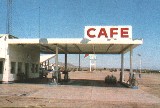 In Amboy we came across an inviting gas station with a willow
tree and a CAFE sign with red letters 12 ft high. A perfect place
for pulling off the desert. The cafe was cool, bright and polished
inside: lots of stainless steel coolers with that sweating, refrigerated
look. We had iced tea, soup and coffee with a side of ice water.
"This is a nice place," Barb said. I was nodding when
a man with a pressurized canister and nozzle asked us to move
our feet so he could spray the crack along the bottom of the counter.
In Amboy we came across an inviting gas station with a willow
tree and a CAFE sign with red letters 12 ft high. A perfect place
for pulling off the desert. The cafe was cool, bright and polished
inside: lots of stainless steel coolers with that sweating, refrigerated
look. We had iced tea, soup and coffee with a side of ice water.
"This is a nice place," Barb said. I was nodding when
a man with a pressurized canister and nozzle asked us to move
our feet so he could spray the crack along the bottom of the counter.
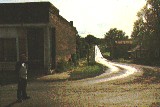 On the other side of Alamosa we passed a hitchhiker who was walking along the highway with his thumb out. He was so drunk that a gust of wind caused him to weave and totter into the road ahead of us. I swerved and narrowly missed hitting him. He was wearing a stars and stripes backpack, a great big felt
hat with a pheasant feather in the band, a fringed leather vest,
bellbottoms with decorative stitching at the cuffs, and he looked
about 48 years old, sun baked and hard as nails. One of those
unfortunate ramblin' alcoholics who's inherited all the unwanted
regalia of the not-so-recent past. I wondered what would happen
to him. It's a very long stagger to the next town anywhere in
eastern Colorado, and hard to get picked up when you're losing
a drunken battle with the wind.
On the other side of Alamosa we passed a hitchhiker who was walking along the highway with his thumb out. He was so drunk that a gust of wind caused him to weave and totter into the road ahead of us. I swerved and narrowly missed hitting him. He was wearing a stars and stripes backpack, a great big felt
hat with a pheasant feather in the band, a fringed leather vest,
bellbottoms with decorative stitching at the cuffs, and he looked
about 48 years old, sun baked and hard as nails. One of those
unfortunate ramblin' alcoholics who's inherited all the unwanted
regalia of the not-so-recent past. I wondered what would happen
to him. It's a very long stagger to the next town anywhere in
eastern Colorado, and hard to get picked up when you're losing
a drunken battle with the wind.
